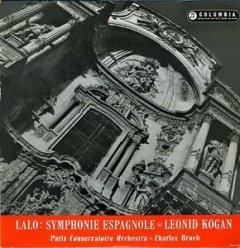The Art Of Leonid Kogan (2014) CD1 Lalo: Symphonie espagnole in D minor op.21 (1955)
The Art Of Leonid Kogan (2014) CD1 Lalo: Symphonie espagnole in D minor op.21 (1955)

1.Symphonie espagnole in D minor Op.21 - I. Allegro non troppo (7:41) 2.Symphonie espagnole in D minor Op.21 - II. Scherzando: Allegro molto (4:09) 3.Symphonie espagnole in D minor Op.21 - III. Intermezzo: Allegro non troppo (6:09) 4.Symphonie espagnole in D minor Op.21 - IV. Andante (6:51) 5.Symphonie espagnole in D minor Op.21 - V. Rondo: Allegro (8:07) Leonid Kogan(violin) Orchestre de la Societe des Concerts du Conservatoire Charles Bruck (conductor)
This concerto-like work is one of the favorite large-scale violin works of the Romantic era. Its colorful Spanish quality and its flowing, attractive melodies, along with its copious display of violin tricks, have kept it before a public that has largely forgotten the other works of its composer.
Stimulated by Pablo de Sarasate's playing of his First Violin Concerto in 1874, Lalo decided to write another concerto, this time paying tribute to Sarasate's Spanish nationality and his own Spanish descent. Lalo tailor-made the new Symphonie Espagnole to fit Sarasate's playing style, which was innovative for stressing a bright, light attack rather than the powerhouse style that had characterized earlier violinists. It is likely that Sarasate collaborated with Lalo in the details of the violin part, for it features the singing line and effervescent arpeggio and scale work that was a trademark of his playing and which are featured in Sarasate's own recital music. Sarasate played it for the first time in Paris on February 7, 1875. It immediately pleased the audience, and happened to hit in the middle of a vogue for Spanish music recently touched off by Bizet's opera Carmen.
It has frequently been said that it is not a concerto or a symphony at all, although it does have elements of symphonic form. It is really a suite, whose five movements add up to the dimensions of a symphony, about 30 minutes.
The first movement, Allegro non troppo, opens with a full-orchestra statement of a theme that stresses a typical 2/4 + 6/8 Spanish rhythm. The violin then states a main theme in triplets. The soloist also introduces a second subject, which is the main material for the development, where it acquires the triplets of the other subject. The coda has a brief development of the first subject.
The second movement, Scherzando; Allegro molto, is a sparkling fast Spanish waltz, which follows an introduction featuring bright pizzicato writing for the orchestral strings. The outer portions of the three-part form are in the Spanish rhythm called the seguidilla. The middle part of this movement is rhapsodic, with frequent shifts of tempo.
Lalo made the symphony a five-movement work by adding an Intermezzo as the third movement after the premiere. It is, in effect, a second scherzo, though in a slower tempo. It has a nice use of the contrast between minor and major modes. Unfortunately, for some years many violinists adopted the practice of omitting this movement. That is a shame, for the sultry second subject is one of the nicest themes in the symphony.
The true slow movement is the sultry and romantic fourth movement, Andante, with a dark and soulful mood.
The finale is a rondo whose main subject sets off a series of dazzling episodes. Lalo begins the movement with a nice trick to raise anticipation: he repeats an accompaniment many times until the violin inserts the theme. After that the movement continues in dance-like mode until the brilliant conclusion. --- Joseph Stevenson, Rovi
download (mp3 @320 kbs):
yandex 4shared mega mediafire zalivalka cloudmailru oboom uplea








